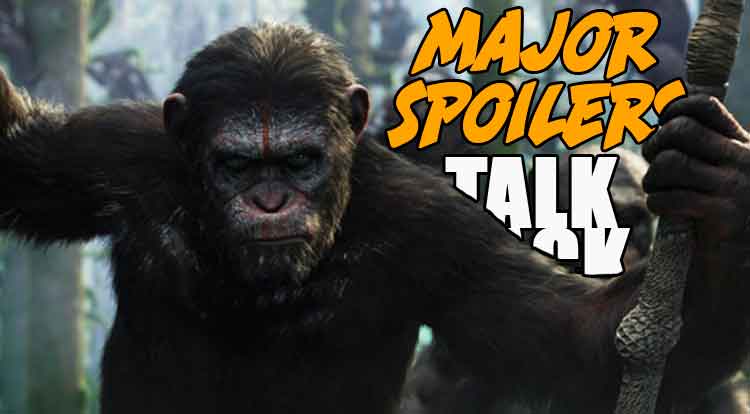The latest installment of the new Planet of the Apes franchise has arrived and took the box office by storm!
A growing nation of genetically evolved apes led by Caesar is threatened by a band of human survivors of the devastating virus unleashed a decade earlier. They reach a fragile peace, but it proves short-lived, as both sides are brought to the brink of a war that will determine who will emerge as Earth’s dominant species.
Were you able to get to the theater this weekend to watch the movie? What did you think? Is this the natural progression of the new Planet of the Apes timeline, or do you miss time traveling Cornelius and Zira? Use the comment section below to share your thoughts, reactions, and of course SPOILERS for the new film.




2 Comments
Finally had a chance to get to the theatre to see Dawn (or as a friend calls it, “Horizontal Emergence of the Terrestrial Body of the Simians”) . . . My first impression was confusion. My second was annoyance. Now I’m just sad.
The trailers implied a great battle between apes and humans: “We spent 10 years fighting the virus and ten years fighting each other.” “I need to speak to Caesar!” And the images of Caesar calling for an attack by the other apes of the clan. Turns out, neither quote is in the movie. And the attack is for the apes to hunt down a herd of antlered things (elk, maybe? My degree is in Linguistics, not Biology)!
Anyway, the movie follows two plotlines: 1) surviving humans trying to restore an hydroelectric plant located in the apes’ forest and 2) an internal struggle for power between Caesar and Koba.
Plot One: Twenty years after the virus that leaves 1:500 alive, a group of 40-somethings (and one 50-something) try to restore power to an hydroelectric plant. Are we to believe that the surviving human population (remember, 1:500 left alive) primarily composed of what must be college dropouts (40-something minus 20 years) have the knowledge to restore an abandoned hydroelectric plant by replacing a few electronic parts and some C-4 to clear the branches?
BTW, very simple math gives the surviving human population of the Bay Area as about 15K (7.5M x 1:500) and the entire state of California as about 77K (38.5M x 1:500). Luckily, there is a specialist in every required field left!
Plot Two: Koba, the ape that Caesar “cookies” in Rise, spends the entire film plotting an overthrow of Caesar so the apes can attack and destroy the surviving humans. Koba kills the one human in the repair party that doesn’t like apes, shoots Caesar, and sets fire to the apes’ home. He blames everything on the humans and almost converts Caesar’s son — Blue Eyes† — to his cause. Eventually, Caesar is found alive, given medical attention by the humans, and confronts Koba. In a final battle, Caesar defeats Koba, accuses him of not being an ape, and pushes Koba to his death:
“Ape shall not kill ape (unless it moves the plot along).”
† Blue Eyes should have been named Bright Eyes (Taylor’s nickname from the original Planet of the Apes).
I understand that science fiction is nearly always used as allegory for the human condition, but sometimes I want to see what is possible if civilization was able to start from scratch. And that is what the Planet of the Apes could have been. Apes have the intelligence to create a higher form of society, but in Dawn they drag along all the trappings of the humans from which they escaped.
Standout Comparison: Maurice is shown teaching the young apes how to read and write, while the humans spend the entire movie gathering weapons and trying to restore electricity.
And the most disappointing thing: The movie poster shows apes in front of a destroyed Golden Gate Bridge . . . Do I really have to tell you that in the movie it isn’t?
Reading additional comments and synopses has brought a glaring question to light: How long has it been since Rise of the Planet of the Apes?
Various interviews (and the official website) state that Dawn takes place ten years after Rise, but the original teaser stated “We spent ten years fighting the virus, and another ten years fighting each other.”
One of the trailers changes that to “It took us four years fighting that virus, but we are survivors.”
Finally, I can’t imagine that much overgrowth occurring in only ten years.
So, how long has it been?